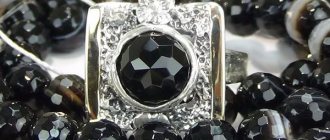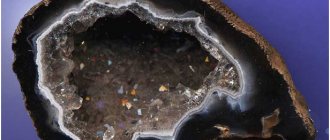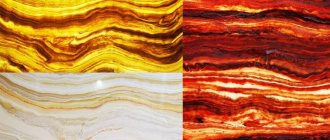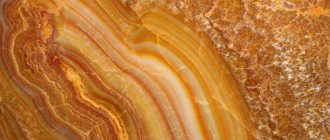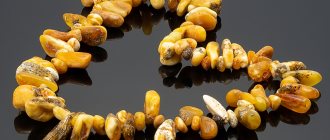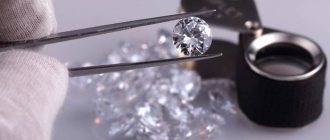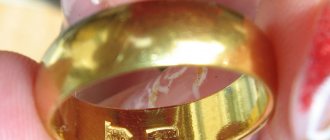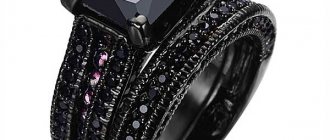A huge amount of semi-precious stones and minerals are mined in the world, many of which, due to the same origin, are similar in appearance. A striking example of twin stones are agate and onyx - striped minerals that are difficult to distinguish from each other to an uninformed person. Trusting buyers are misled by sellers selling black onyx - agate colored in a dark shade or obtained naturally. Before agreeing to the persuasion of sellers who claim that there is no difference between the stones, you should find out how they differ.
Agate and onyx: are they the same thing?
Sellers in jewelry stores, in the absence of one mineral, often offer another, assuring that agate and onyx are the same thing. However, this is not so: minerals are close relatives and have much in common, but still differ from each other. To understand the difference between stones, you should study the characteristics in more detail.
Agate and onyx are classified as ornamental minerals, which have always attracted people's attention with their beauty and patterns. Both stones are considered a variety of layered chalcedony. In terms of physical properties and chemical composition, gems have much in common:
- equal hardness;
- resistance to acids;
- transparency around the edges;
- the set of color tones is similar;
- density over 2.6 g/cu.m. cm.
The minerals are not identical. The main, but not the only, difference between gems is their color.
Find 4 differences
In fact, these two stones of the same breed and nature have similar energy and strength, so if you suddenly purchase one instead of the other, you will not make a fatal mistake. There are certainly some differences, but they mainly concern the appearance of the stones and their place of origin.
Judge for yourself:
- In agate, the contrast of layers is not very pronounced, the transitions are hardly noticeable. Onyx has more distinct layering.
- If you carefully examine the pattern on the agate, you will notice that it consists of thick stripes (not parallel) or a concentric pattern. Onyx is more “regular”; the lines on it are thinner, but almost perfectly parallel.
- Agate has a deep matte shine, unlike onyx, which sparkles with a glossy surface.
- Agate deposits: Armenia, Russia (Ural), Brazil, Georgia, Tajikistan. Onyx is mined in our country in Kolyma and Primorye, as well as in Uruguay, the USA, and India.
Knowing these features, you can easily guess that the first photo shows agate, and the second shows onyx.
It is interesting that both agate and onyx were discovered in ancient times. Even then, minerals were valued and loved not only for their aesthetic properties, but also for their power.
The first agate, according to legend, was found in Sicily near the Achates River. According to one version, the name of the stone came from it. Another version says: the word “agate” is nothing more than a translation of the Greek word “happy, fortunate.”
The mineral that brings happiness is now a favorite of all jewelers, and, of course, buyers and collectors of natural gems. And really, how can you not love him? By collecting pieces of stone of all colors (and there are at least two dozen of them), the artist will create a unique panel or painting, and from a solid agate, the size of which can reach a meter or more, the sculptor will build a real masterpiece.
What is the difference between agate and onyx?
To understand the differences between stones, you should take into account the following details:
- In agates, the contrast of layers is weakly expressed, the boundaries between the lines are inconspicuous.
- The pattern of agates is a unique pattern - each stone is original, and there are no two copies with the same pattern in nature. Onyx has parallel rather than ring-shaped lines.
- The luster of agates is matte, while that of onyxes is glassy.
- The agate is not transparent, but is slightly translucent at the ends. Onyx has the same qualities, but less pronounced.
- Agate deposits are located in India, Russia, Georgia, and Armenia. Onyx stones are mined in America, Brazil, Uruguay, Algeria and Mexico.
- Natural striped gems do not come in one color. The agate palette includes lemon, crimson, pink and other shades. Ordinary onyx is decorated with dark and light stripes, but some specimens are decorated with scarlet, gray or brown inclusions.
Differences
Despite a wide range of general similarities, onyx is slightly different from agate. There are few such discrepancies, and they are not particularly fundamental:
- onyx has glossy reflections, while agate is a matte precious mineral (a special shine is achieved after special processing);
- each representative of the older brothers of the agates has a unique and inimitable, sometimes chaotic pattern of stripes; while the “color” of the younger one resembles someone carefully constructed parallel lines;
- the stripes on onyx are thinner and more graceful;
- the color scheme of black onyx changes in accordance with clearly defined zones on the stone; agate has smoother tints;
- onyx is usually classified as a cold stone, its older brother – as a neutral one;
- the cost of onyx is higher, since it is rare and valued among jewelers, but at the same time, agate is widely popular in comparison with its younger brother.
At the end of the comparison, it can be noted that the fundamental differences between minerals relate exclusively to their appearance. And this is not surprising - after all, black onyx is just a more expensive, rare and refined variety of agate. Therefore, you can safely purchase one of the brothers instead of the other - after all, they are really almost twins with identical properties.
Types of minerals
Both minerals are divided into many varieties. Classic agate is a stone with blue-gray and light layers that form a beautiful pattern. The group of agates is divided into varieties depending on the patterns:
- ocellar;
- star-shaped;
- cloudy;
- ruinous;
- tape;
- landscape;
- sapphirine (blue);
- iridescent.
Onyx is also divided into types depending on color and pattern:
- Arabic - black and white mineral;
- carnelian - red and white lines;
- sardonyx - specimens with brown and light stripes;
- chalcedonyx is a gray-white mineral;
- Onyx is a stone with alternating light and dark gray lines.
Separately, mention should be made of the popular variety called black onyx. In nature, an absolutely black stone does not exist; there are dark specimens with faint layers. Black onyx is just a trade name used for agates.
All-coal mineral is obtained in two ways:
- Coloring. In ancient times, carbon was used to impart a charcoal color; now cobalt nitrate is used.
- The natural way . Sometimes you come across agates in which the thickness of the dark layer is several cm. To obtain black onyx, this dark layer is cut and processed. However, it is important to note that calling such a stone onyx is incorrect, because the word “onyx” implies alternation, and not a single color.
What do onyx and nails have in common?
Here are some interesting facts about agate's twin brother, onyx:
- In nature you can find not only white, but also gray, as well as red, yellow and brown onyxes. The most valuable of them stands apart - black onyx, which is essentially a black agate, which is credited with healing and magical powers. No, this is not a stone of sorcerers at all, although magicians used it in their rituals before. For a bright person with good intentions, black onyx will give strength, health, good luck in all matters, peace of mind and understanding in the family.
- Perhaps the most famous onyx belonged to the Vatican minister Benvenuto Cellini. He had a stone uniquely handmade by an unknown master. The Last Supper was laid out inside the colored onyx mineral! All of Jesus' disciples are in colorful robes, and He himself is in white. Truly painstaking work. Now this stone is kept in St. Peter's Cathedral.
- The name "onyx" comes from the Greek word for "nail".
- An onyx pendant or pendant has a beneficial effect on digestion, and earrings have a beneficial effect on hearing. Products with the mineral provide strength not only to the body, but also to the spirit and mind. Those whose work involves a computer are recommended to rub their earlobes with onyx before starting the work day. See how much your alertness and productivity will improve!
- There are no perfectly smooth onyxes in nature. Their beautiful shape is the result of the painstaking work of jewelers, and sometimes a sign of a fake.
History and origin
Another difference between the layered beauties is the history. Stones have been known to mankind since ancient times, and the history of each representative is interesting and informative.
The mineral onyx gets its name from the Greek word “onychion,” which translates as nail.
According to Greek legend, Aphrodite's son, Eros, was somehow playing around and hit his mother's finger with an arrow, from which the nail fell to the ground, turning into a striped mineral of amazing beauty. From Arabic the name is translated as “sad”, since the stone was often used to decorate tombs, for example, the Gur-Emir mausoleum in Samarkand.
The history of agate is no less interesting. According to the first version, the name of the mineral is translated from Greek as “useful” or “lucky.” Another version says that the gem received its name from a river in Sicily - Ahastes (Dirillo).
The stone has been known to people since ancient times; proof of this is a ship built BC. e., the floors of which were covered with agates and other minerals. Striped stones were prized by the Sumerians and Egyptians - they were used to create jewelry that was found in Sumerian cities and the tomb of Pharaoh Tutankhamun.
The origin of the gems is the same - presumably volcanic. Rocks form in the voids of solidified lava through diffusion. According to another version put forward by scientists, minerals owe their appearance to silicic acid and solutions settling in rock cavities.
Origin of stones
Black agate and black onyx are born as a result of volcanic processes, which at a later stage form mineral associations. First of all, thanks to the favorable and effective outpouring of lava flows (ash deposition in the water column is not excluded). Much less often, mineral deposits can arise in hydrothermal veins, characterized by their low temperatures (in this case we are talking about surface nucleation - sedimentary rocks of carbonate or clay composition, weathering crusts).
Based on the above, we can conclude that it is quite difficult to bring the conditions for the formation of stones to some general and most favorable conditions. Therefore, the geological and chemical conditions of the origin of minerals are very diverse and lack systematic character.
If we talk about industrial deposits of onyx and agate, then in most cases we are talking about volcanogenic complexes - more often basalts, less likely - andesites, sometimes - rhyolite surfaces.
Almond-shaped stones (regardless of size parameters) most often originate in effusive rocks, which are lavas mixed with bubbles. The composition of such masses is dominated by the same andesites, as well as basalts and melaphyres. In this process, the main role is played by the correct circulation and interaction of mixtures of a colloidal nature, and represents the last step in the hydrothermal process.
In order to determine the temperature of formation of black agate and black onyx, researchers at one time used the technique of aluminum quartzization and oxygen isotope content. As a result, it became known that the ideal temperature for the birth of minerals is a very wide range - 60–200°C. However, there are known cases of stone formation in a colder environment - 20–30°C, but in this aspect we are talking about the artificial production of minerals.
The geography of the origin of black onyx is wide - the USA, Brazil, India, Uruguay, some regions of Russia - Primorsky Territory, Kolyma, Chukotka.
Agate deposits are no less widespread on the territory of the Arabian Peninsula, as well as Mongolia, Armenia, Georgia and Russia (Magadan region, Magnitogorsk, Golutvin).
Areas of use
Striped minerals are used in the same areas: stones are used to create jewelry, candlesticks, seals and for interior decoration. In addition, they are valued and loved by esotericists, magicians and healers.
What are striped varieties used for:
- Since ancient times, onyx There are references to such decorations in the Bible. The most famous example in the world belonged to Benvenuto Cellini - the Last Supper is depicted inside the colored stone.
- Agates are used to create mortars and pestles for chemical experiments, prisms and stones for scales and watches, jewelry, dishes and figurines. A huge dish is kept in the Austrian Kunsthistorisches Museum - the diameter of the product is almost 0.75 m. In the Middle Ages, the mineral was ground into powder and treated for patients from snake or scorpion bites.
Interesting facts about agate
You might be interested to know that:
- Agate has long been used to make not only jewelry and household items, but also talismans with amulets for good luck and protection from evil people.
- Farmers in Rome wore it to ward off bad weather, natural disasters and to get a good harvest.
- The Italians valued agate for its assistance in trade.
- In the Middle Ages, healers used agate powder to treat fatal insect bites, as well as many other diseases. A stone in the mouth prevented bedridden patients from suffering from thirst.
- The most common color of this stone in nature is blue and grayish. Typically, such minerals do not have a special name, while brighter specimens with fancy patterns have their own names: landscape agate, moss agate, frost agate, fire agate and others.
- Agate with a concentric pattern in the shape of an eye is believed to be endowed with the ability to distinguish people with good intentions from evil ones. Legend has it that such a stone is nothing more than the hardened eye of an eagle that fell in battle with an evil sorcerer.
- A huge agate dish with a diameter of 0.75 meters can be seen in one of the Viennese museums. And in Paris there is a Gospel setting inlaid with agates and other gems with the faces of saints - a real work of art made by the hands of jewelers from the Rhine.
- It is believed that the female name Agatha is a derivative of the name of the mineral, and endows the girl who wears it with incredible feminine attractiveness and even magical abilities.
What is more expensive: onyx or agate
Despite their uniqueness and amazing beauty, onyx and agate are not precious stones. Many collectors do not pay attention to this and are happy to add valuable specimens to their collections.
The cost of agate, given the beauty of the stone, is modest. The price of a natural mineral will be up to $2 per gram, with a maximum of $110–220 per pebble. However, it is important to note that rare agates with a unique color or design are more expensive. When purchasing jewelry, the cost will be affected by the type of metal and inclusion of other stones.
Compared to agate, onyx is an expensive mineral, as it costs twice as much.
Onyx and agate are two close relatives that share many similar features and characteristics. But despite similar qualities, striped minerals are different - differences are manifested in color, density and luster.
How not to buy a fake
Be careful! Often, agate or even ordinary glass, painted in the desired color, can be passed off as onyx. However, agate, which is somewhat lower in price than onyx, is also counterfeited.
A small reminder on how to distinguish a fake from the original:
- If in doubt, squeeze the stone in a warm palm. The real one will heat up very reluctantly, while the fake one will instantly absorb the temperature of your hands.
- A trained eye will immediately distinguish between a natural mineral and a cheap polymer, which will shine like a piece of plastic or glass.
- Too blurry or, conversely, bright stripes on a stone are a clear sign of a fake.
- Weigh the pebble in your palm. Heavy? Real agate or onyx significantly exceeds even marble in weight, not to mention plastic.
- The boundaries of the layers and veins will be clearly visible not only from the outside. They seem to penetrate the stone and reach a depth of 4 cm or more. On a fake product, these layers will be imitated by a pattern and will not be visible inside.
Despite their semi-precious nature, agate and onyx are highly sought after not only by ordinary buyers, but also by collectors, famous and influential people. But the whole point is that these minerals cannot be called “half-breeds”; some of them are too beautiful.
Many claim that with the purchase of these stones, their life and worldview changed dramatically, peace and prosperity came to their home. At the same time, the cost of agate and onyx is low, although the latter costs twice as much as the former.
